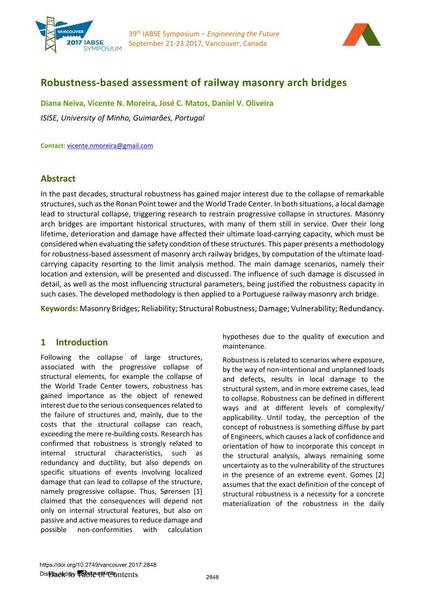Robustness-based assessment of railway masonry arch bridges

|
|
|||||||||||
Bibliographic Details
| Author(s): |
Diana Neiva
(ISISE, University of Minho, Guimarães, Portugal)
Vicente N. Moreira (ISISE, University of Minho, Guimarães, Portugal) José C. Matos Daniel V. Oliveira (ISISE, University of Minho, Guimarães, Portugal) |
||||
|---|---|---|---|---|---|
| Medium: | conference paper | ||||
| Language(s): | English | ||||
| Conference: | IABSE Symposium: Engineering the Future, Vancouver, Canada, 21-23 September 2017 | ||||
| Published in: | IABSE Symposium Vancouver 2017 | ||||
|
|||||
| Page(s): | 2848-2855 | ||||
| Total no. of pages: | 8 | ||||
| Year: | 2017 | ||||
| DOI: | 10.2749/vancouver.2017.2848 | ||||
| Abstract: |
In the past decades, structural robustness has gained major interest due to the collapse of remarkable structures, such as the Ronan Point tower and the World Trade Center. In both situations, a local damage lead to structural collapse, triggering research to restrain progressive collapse in structures. Masonry arch bridges are important historical structures, with many of them still in service. Over their long lifetime, deterioration and damage have affected their ultimate load-carrying capacity, which must be considered when evaluating the safety condition of these structures. This paper presents a methodology for robustness-based assessment of masonry arch railway bridges, by computation of the ultimate load- carrying capacity resorting to the limit analysis method. The main damage scenarios, namely their location and extension, will be presented and discussed. The influence of such damage is discussed in detail, as well as the most influencing structural parameters, being justified the robustness capacity in such cases. The developed methodology is then applied to a Portuguese railway masonry arch bridge. |
||||
| Keywords: |
reliability damage redundancy vulnerability structural robustness masonry bridges
|
||||
